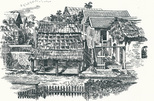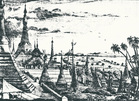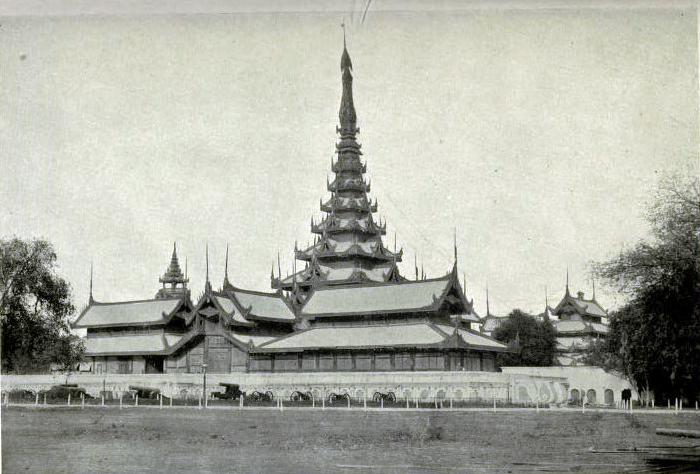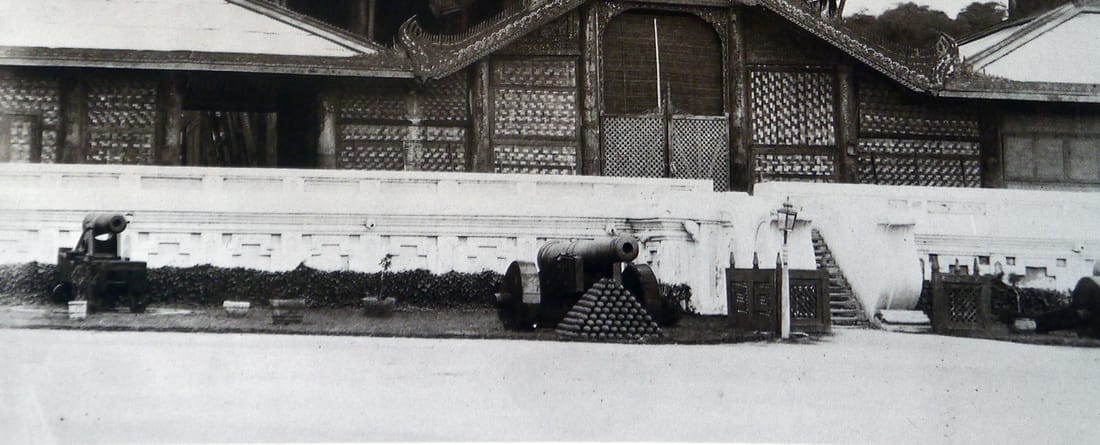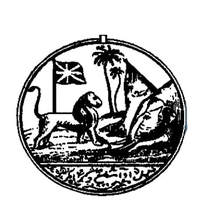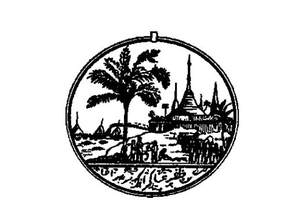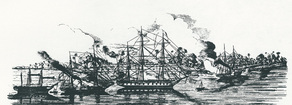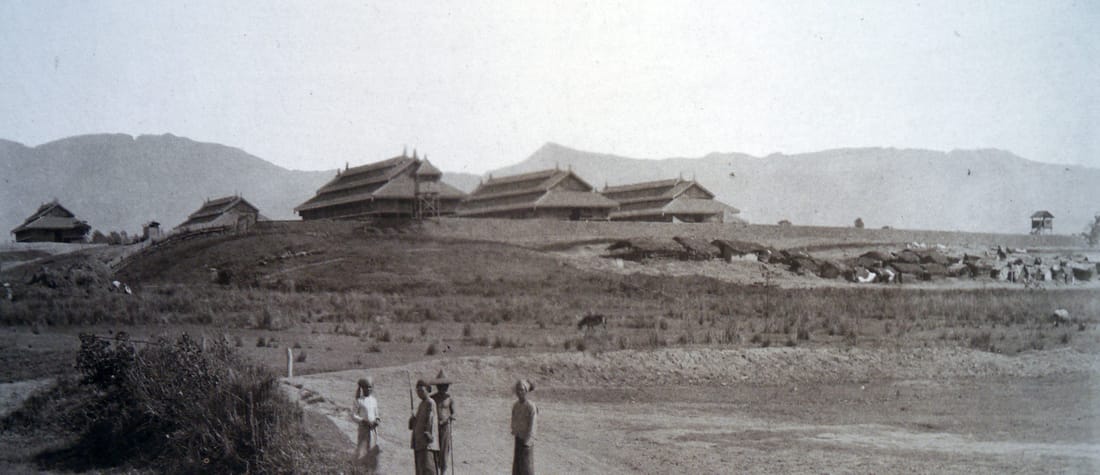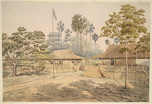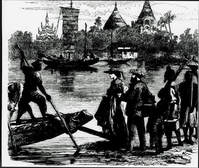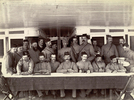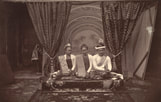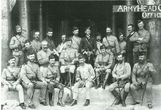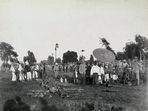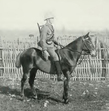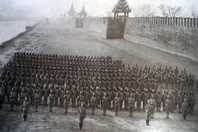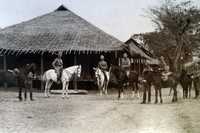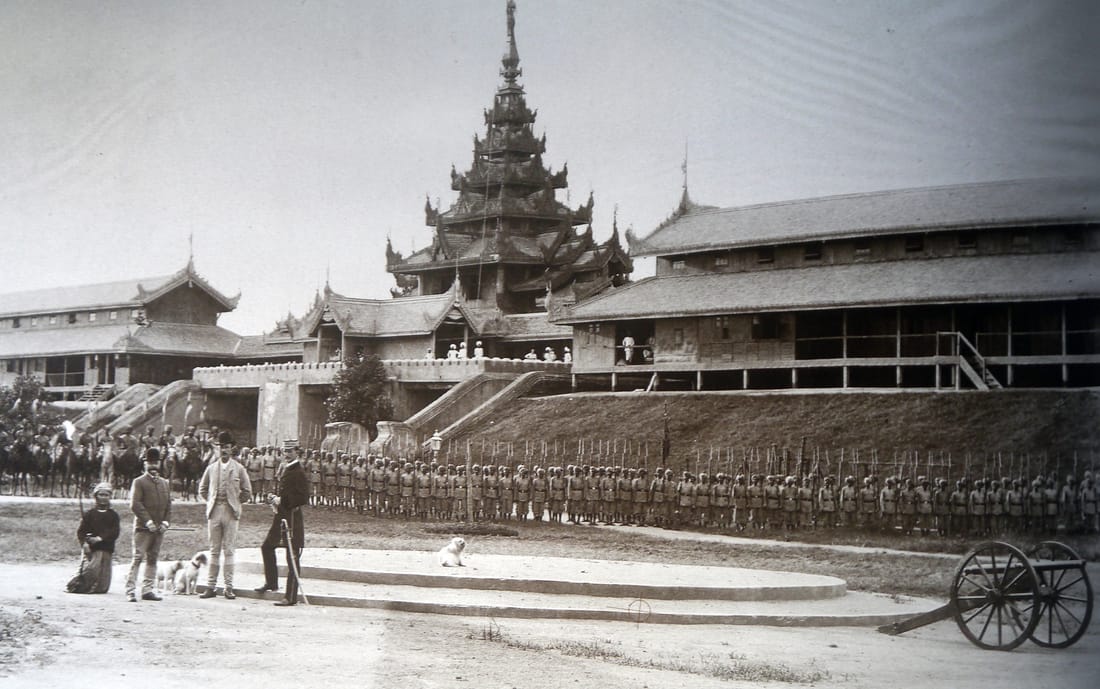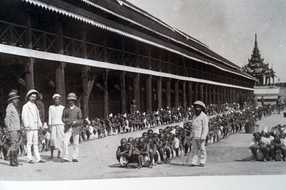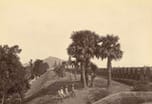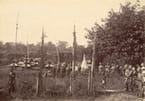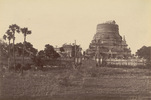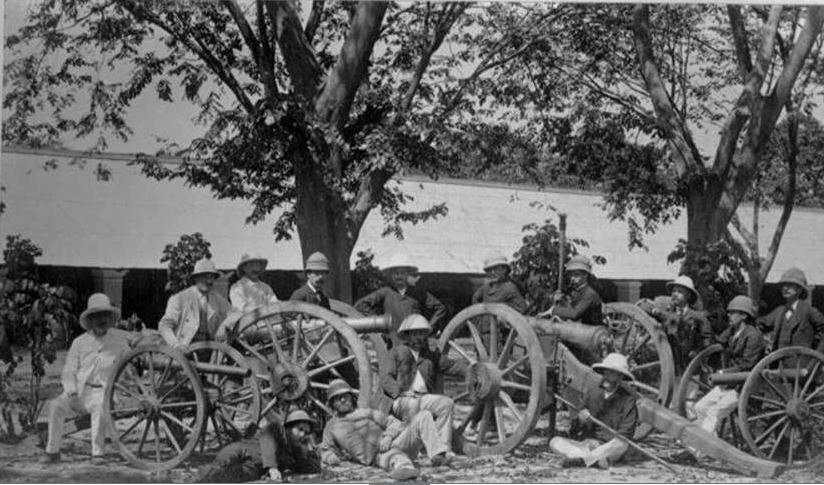Sentry Page Protection
Please Wait...
Scenes from the
Anglo-Burmese Wars
under construction
The first A-B war was with the East India Company and ended with the Treaty of Yandabo.
The gain was Assam, Arakan, Ramree, Cheduba, Sandoway and part of Tenasserim.
The gain was Assam, Arakan, Ramree, Cheduba, Sandoway and part of Tenasserim.
|
Maha Bandoola, (Mg Yit or Maung Phyew)
1780-1825 |
Maha Bandoola
|
General Thado Thuhamma-yaza Maha Bandoula,
his youthful name was Maung Yi |
Danubyu, this Pagoda was erected by King Mindon Min to the memory of
General Bandoola |
|
The landing at Rangoon, 1824. Aquatine by Joseph Moore
|
The Steamer "Diana" Conflaguration at Dalla, 1824 - she was the first steamer to be seen in the east. Aquatint by Joseph Moore
|
Storming of the Lesser Stockade, Kemmendine, 1824
Aquatint by Joseph Moore |
The principal approach to the Shwedagon, 1824
|
Minhla Fort
Fort Minhla, is situated on the Irrawaddy, this and two others, Asay Gan or Sagaing Fort (west bank) and Inn Wa Fort were commissioned by King Mindon Min in 1874 and built by Captain's Camotto, Barbieri and Molinari, Italian Naval Officers/Engineers in co-operation with Burmese Engineers.
A slideshow of photos of the the other two forts can be found at the end of the page.
Cannons
The Ava Medal
Presented to the British troops at the Annexation of Burma
Presented to the British troops at the Annexation of Burma
The gain this time was the entire coast line.
".. So Rangoon was taken in a manner which reflects nothing but credit on the courage of both attackers and defenders. It may be noted that whereas in 1824 the town and Pagoda had been taken without the loss of a man, in 1852 the attaching forces lost 16 killed and 133 wounded, besides some thirty of the naval force."
|
William Appleby
A soldier who took part in the 2nd A-B war, wrote to his brother from Prome about his experiences. This eye-witness account covers most of the active phase of this war. He describes the occupation of Rangoon, the action took a number of days during which there were British losses, in some cases from severe heat. Sailing up the Irrawaddy for the attack on Prome and Ava he recounts the conditions including a night plagued by mosquito's and out breaks of cholera. He also reproduces the text of the Proclamation to the King dated 20th Dec. 1852 annexing Pegu. |
Names mentioned in Appleby's letters:-
Joseph & Elizabeth Appleby (his bother and sister) Lt. Armstrong Lt.-Col. Reynolds Commander Tarleton Maha Bandoola G. Allen Maj. Genl. Godwin John Richardson |
|
Toungoo c. 1880, probably Military Quarters
|
Toungoo was a vital frontier station after the 2nd A-B war until 1893 when the troops were withdrawn. |
Cantonment, Rangoon 1866
|
Cantonment, looking S. S. E. Pazundaung Creek is in the left distance; the new barracks of H.M. 84th Regt. are in the centre. Occupying over 2 miles in Rangoon. The Shwe Dagon Pagoda was within its limits and was used for military purposes and being completed vacated in 1920.
|
Colesworthy Grant sketched the following portraits and made comments about each gentleman. Grant was the official artist with the Mission to the Court of Ave, 1855. In recognition of his ability King Mindon Min presented him with a gold cup and a ruby ring. Major Phayre's Mission was to persuade the King to sign a treaty acknowledging British rule over Pegu Provence which was annexed after the 2nd A-B war in 1852.
|
McKertich J. Mines
|
"Mr Mackertich is an Armenian but naturalized to Burmah. He was one of the Burmese Embassy to Calcutta in 1854 and on the English reaching Melloon, of which he was then Governor, he formed a member of the deputation appointed to escort the party from that place to the royal capital at Amarapura. Mr Mackertich speaks English well and is a shrewd and intelligent man. He is repeatedly referred to in the report."
|
Sir Arthur Phayre
|
Sir Arthur Purvis Phayre, 1812-1885
Commissioner of Pegu, 1852-1863 First Chief Commissioner, 1863-1867 |
|
Thomas Spears
|
Thomas spears was a Scottish merchant and an authority on Burmese culture who played an informal diplomatic role in the wake of the war and helped to negotiate the Mission. Grant records that he was "the only British merchant and resident at Umerrapoora to whom the members of the mission were indebted for many valuable and friendly attentions. Mr Spears has resided in Umerapoora about eighteen years. He was a sufferer by the rebellion of 1852 and during nine months was kept a prisoner in irons. He is much respected by the King and no less so by his countrymen, having at all times honourably maintained his character as an Englishman."
|
Antonio Camaretta
|
Akouk-woon or Collector of Customs for the King of Ava at Amarapura. Portuguese by birth and a favourite of the King, he was in the Burmese service over 30 years. He also suffered at the time of the rebellion in 1852 and spend nine months a prisoner in irons with Mr Spears.
|
|
R.S. Edwards
|
"A Mission to Ava would hardly be perfect without the customary aid of Robert Samuel Edwards as an attaché. He had become historically connected with Burmah where his services, fidelity and intelligence are as well appreciated by the Government as his character, conduct and disposition are respected in the circle of private life. Mr Edwards has served the Government for upwards of forty years."
|
Moung Gya Oo
|
Moung Gya Oo was the Chief Minister at the Court of Ava.
|
|
1855
British Residency, Amarapura |
1855
Infantry soldiers, Amarapura |
1855
Fr. Abbona |
Fr. Abbona, R.C. priest & confidant of the King, had a successful mission in Mandalay, his chapel and the houses of the Christians were without the city walls. He also had a boys school in the premises and a girls school outside the church premises.
|
1855
Genl. D'Orgoni |
General D'Orgoni was resident at Amarapura, he had accompanied Burmese officials on a mission to the King of France.
|
Extracts from
"A Photographic Expedition in 1862"
See below for a brief narrative.
"A Photographic Expedition in 1862"
See below for a brief narrative.
Mandalay
Feb. ... As we came near Mandalay we saw a little Burmese steamer preparing to start. A son of Cameretta, the Court favourite was on board. He tells us that the city walls of Amerapoora are pulled down and that cotton grows where the palace stood five years ago.... and anchored finally close to the royal barge. This boat is really beautiful as well as curious. You must imagine a tall, elegant tower, placed upon two gilded canoes. The prows are in the shape of griffins bestridden by fabulous birds called karawicks. Figures of the king and the nats (fairies) are on either side of the griffins. All these are covered with looking-glass in mosaic, having the appearance of plate-armour. The sterns are very tall, of pierced work, surmounted by canopies hung with bells. Every portion of this floating tower is elaborately carved and gilded....
Mar. ... Fr. Abbona a Romish priest has a successful mission here, his chapel and the houses of the Christians are without the city walls. (Also has a boys school in the premises and a girls school outside the church premises.)
... An interview with Camaratta (A European who is a great favourite at court.)... we set off from Mandalay for Meengoon where there is an enormous pagoda ... on the north side of the pagoda is the largest bell in Burmah. A low wall of about four feet in height enclosed a considerable area, in the centre of which was a circular platform of five low terraces. Upon the platform were two pillars of solid masonry and from timbers fastened together by copper or iron bands hung the bell and the stout cross-beams were actually bent by it enormous weight. The base of the bell was supported by wooden figures of crouching nats or bilous and the comical expression, still visible on the faces of one or two seemed to remonstrate against the weight. There was just sufficient room to crawl under the lip of the bell. Pieces of gold, which had been thrown in evidently during the founding, were visible...
Feb. ... As we came near Mandalay we saw a little Burmese steamer preparing to start. A son of Cameretta, the Court favourite was on board. He tells us that the city walls of Amerapoora are pulled down and that cotton grows where the palace stood five years ago.... and anchored finally close to the royal barge. This boat is really beautiful as well as curious. You must imagine a tall, elegant tower, placed upon two gilded canoes. The prows are in the shape of griffins bestridden by fabulous birds called karawicks. Figures of the king and the nats (fairies) are on either side of the griffins. All these are covered with looking-glass in mosaic, having the appearance of plate-armour. The sterns are very tall, of pierced work, surmounted by canopies hung with bells. Every portion of this floating tower is elaborately carved and gilded....
Mar. ... Fr. Abbona a Romish priest has a successful mission here, his chapel and the houses of the Christians are without the city walls. (Also has a boys school in the premises and a girls school outside the church premises.)
... An interview with Camaratta (A European who is a great favourite at court.)... we set off from Mandalay for Meengoon where there is an enormous pagoda ... on the north side of the pagoda is the largest bell in Burmah. A low wall of about four feet in height enclosed a considerable area, in the centre of which was a circular platform of five low terraces. Upon the platform were two pillars of solid masonry and from timbers fastened together by copper or iron bands hung the bell and the stout cross-beams were actually bent by it enormous weight. The base of the bell was supported by wooden figures of crouching nats or bilous and the comical expression, still visible on the faces of one or two seemed to remonstrate against the weight. There was just sufficient room to crawl under the lip of the bell. Pieces of gold, which had been thrown in evidently during the founding, were visible...
The 3rd A-B War
1885/6
Resulted in the deposition of King Thibaw and the entire country being taken over.
"After a fierce engagement the British took the Minhla Fort on 17th Nov. 1885."
1885/6
Resulted in the deposition of King Thibaw and the entire country being taken over.
"After a fierce engagement the British took the Minhla Fort on 17th Nov. 1885."
|
S.S. "Ayeyarwady," one of King Thibaw's war ships, fully armed, 1885
|
S.S. "Ayeyarwady" (the larger ship) captured under the walls of Minhla Fort by the gunboat "Kathleen" and the S.S. "Irrawaddy," 1885.
Photo by Willoughby Wallace Hooper |
Troops landing at Zingyandoung, 1885, "It was here that the first shot was fired.
A short distance above this point, round the corner of the hill seen in the picture, the Burmese had constructed a masked battery, commanding a narrow passage of the river and on the approach of the "Kathleen" and the "Irrawaddy" they opened fire." The battery was shelled by the "Irrawaddy" and the Burmese abandoned the position. Photo by Willoughby Wallace Hooper |
Bagan, 22nd Nov.1885,
arrival of the Flotilla at Myoungoo - King Thibaw's ships scuttled. Photo by Willoughby Wallace Hooper |
|
The caption on the "Graphic" (left) 19th Dec. 1885 reads: "The Expedition against the King Theebaw - the I.F.C. steamers at Thayetmyo, ready for the advance on Mandalay Nov. 14th 1885
"Thooreah" (11th Bengal Regt. ) "Yankeentoun" (Liverpool Regt.) "Aloungpyah" (Welsh Fusiliers) "Thambyadine" (the General and Staff.)" |
Thayetmyo, 1885.
The British fleet on it's way to attack Mandalay. Photo by Willoughby Wallace Hooper. |
Paddle Steamer “Yunan” (transport No. 12.) of the I.F.C.
6th Nov. 1885. Towing Flat “Wild Swan” armed with six 9” Howitzers manned by the Royal Artillery, the gun crews being protected by boiler plate. The gun flat was the I.F.C’s. oil flat "A.P. Min." |
|
Capt. Beckett, Commander of the I.F.C. steamer "Palow" provided the Irrawaddy Magazine in 1928 with a description of the steamers and their role during the wars including some events of the 3rd A-B war in 1885.
|
P.S. "Palow"
as transport A., Magwe Nov. 1885, armed with Nordenfeldt guns and is seen towing H.M.S. “Bulldog” on port side and accommodation flat on starboard side. |
Gun Boat "Kathleen"
armed with two guns, (fore and aft) She was the leader of the fleet of I.F.C. steamers which took Mandalay in Nov. 1885. |
|
Officers on board the SS "Tenasserim," 1885,
photo by Willoughby Wallace Hooper |
Officers on board the SS "Irrawaddy," 1885, Genl. H.H. Foord 21st M.I. was the C.O. Photo by
Willoughby Wallace Hooper |
British arrival at Mandalay, 28th Nov. 1885, photo by Willoughby Wallace Hooper
|
Ava, 1885, The Woon (Minister) under his golden umbrella and Col. Sladen at a ceremonial laying down of arms, photo by
Willoughby Wallace Hooper |
Ava, 1885, The Royal Artillery dismantle the Burmese guns, photo by Willoughby Wallace Hooper
|
|
King Thibaw and Queen Supayalat
Mandalay Palace, c. 1880's. Photo by Klier |
King Thibaw and Queen Supayalat, in Court Dress, Mandalay Palace, c. 1880's. Photo possibly by Mattie Calogreddy
|
King Thibaw, Queen Supayalat and her sister Princess Supayaji, Mandalay Palace, 1885. Photo possibly by Mattie Calogreddy
|
Military Officer of King Thibaw
with his wife in Court Dress |
|
King Thibaw's South Garden Palace, Mandalay, 1885, a kind of picnic/Summer house, he was here when the British arrived to dethrone him.
Photo by Willoughby Wallace Hooper. |
The South Garden
or Summer Palace, c. 1880's. |
The King is given ten minutes grace.
29th Nov. 1885. Melton Prior's drawing of the deposition of King Thibaw. Col. Sladen is shown on the left of Genl. Prendergast. |
Fort Dufferin (ex Mandalay Palace) c. 1885
|
Mandalay Palace, 1886, thickness of the Earthworks inside the walls. Photo by Willoughby Wallace Hooper
|
Pyntha, Shan Hills, 1886. Photo by
Willoughby Wallace Hooper |
Ava, British signalling station on the top of an unfinished stupa c. 1886. Photo by Willoughby Wallace Hooper
|
Myingyan
|
Captured Cannons
|
Further Reading
An article donated by Hew Prendergast, g. grandson of Major-General Sir Harry Prendergast. Memorials and Trophies - 3rd Anglo-Burmese War.
Bill Clements of the Fortress Studies Group has provided us with this in-depth history of the Fortifications of the Kingdom of Burma.
M. Montmorency - report on the Fortifications at Ava, 1827.
Passion, Betrayal and Revenge in the Court of Ava, 1885. A potted history by Sandra Carney.
Bill Clements of the Fortress Studies Group has provided us with this in-depth history of the Fortifications of the Kingdom of Burma.
M. Montmorency - report on the Fortifications at Ava, 1827.
Passion, Betrayal and Revenge in the Court of Ava, 1885. A potted history by Sandra Carney.
Thapyaytan Fort, Ava, 2013
Commissioned in 1874, completed in 1878.
Commissioned in 1874, completed in 1878.
|
|
Inn Wa Fort, 2017
This fort is situated at the top of the "triangle" of forts on the Irrawaddy River, commissioned in 1874 by King Mindon Min
This fort is situated at the top of the "triangle" of forts on the Irrawaddy River, commissioned in 1874 by King Mindon Min
|
|








